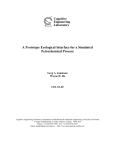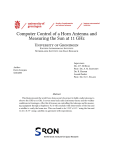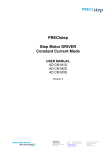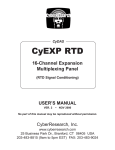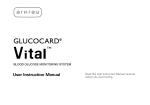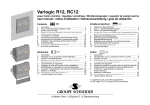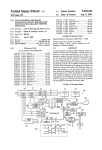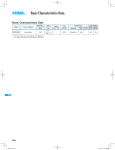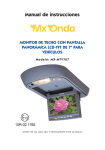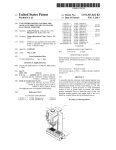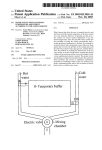Download i——rgu%——
Transcript
US008054039B2 (12) United States Patent Bauerle et a]. (54) US 8,054,039 B2 (10) Patent N0.: (45) Date of Patent: (56) SYSTEM AND METHOD FOR CHARGING A PLUG-IN ELECTRIC VEHICLE Nov. 8, 2011 References Cited U.S. PATENT DOCUMENTS (75) Inventors: Paul A. Bauerle, Fenton, MI (US); 6,424,122 B2 * 7,560,902 B2 * Vernon L. NeWhouse, Farmington, MI 2009/0103341 A1 * (US); Jeffrey T. Wolak, Brighton, MI Xantrex; PROsine 2.0 Inverter/Charger (User’s Manual); 146 pages; (73) Assignee: GM Global Technology Operations WWW.xantrex.c0m. LLC, Detroit, MI (US) (*) * cited by examiner Subject to any disclaimer, the term of this patent is extended or adjusted under 35 Primary Examiner * Kenneth J Whittington (74) Attorney, Agent, or Firm * Lionel D. Anderson; U.S.C. 154(b) by 445 days. Reising Ethington RC. (57) ABSTRACT (21) Appl. N0.: 12/340,079 (22) Filed: uses this information to charge the plug-in electric Vehicle in an optimum fashion that reduces charging time yet avoids damage to components of the charging system. In one Jun. 24, 2010 Int. Cl. embodiment, the battery charging system includes an exter H02] 7/14 H02] 7/04 (52) (58) electric Vehicle With poWer from an external poWer source, such as a standard 110 Volt or 220 Volt AC Wall outlet. The method senses Various internal and external conditions and Prior Publication Data US 2010/0156355 A1 (51) A battery charging system and method for charging a plug-in Dec. 19, 2008 (65) Yagi et al. ................... .. 320/132 Unger ....... .. 320/l4l Lee et al. .................... .. 363/124 OTHER PUBLICATIONS (Us) Notice: 7/2002 7/2009 4/2009 (2006.01) (2006.01) nal poWer source, a battery charger With sensors for monitor ing the external poWer source and the charger, a battery unit With sensors for monitoring the battery, a battery charging control module for processing the information, and a user interface that alloWs user-speci?ed custom charging con straints. All of these components, With the exception of exter US. Cl. ...................................... .. 320/109; 320/162 Field of Classi?cation Search ................ .. 320/ 109, 320/145,132,152,157,158,159,162,l63, 320/164; 903/903, 907; 180/651, 65.21, nal poWer source, may be located on the Vehicle. 180/6529 See application ?le for complete search history. 18 Claims, 2 Drawing Sheets Sense Condition(s) Pertaining to the 102 /\’ External Power Source, the Battery Charger and/orthe Battery Unit i——rgu%—— Evaluate Droop Voltage Evaluate Current Draw Evaluate Power Loss Evaluate Power Draw Evaluate Minimum Constraint and Constraint and Voltage Constraint and Generate Third Generate Fourth Generate Fifth Charging Constraint and Generate Constraint and Generate First Charging Control Second Charging Signal Control Signal 1 10 Charging Control Signal Charging Control Signal Control Signal s s s s 120 130 140 150 Evaluate Charger and Generate Sixth and Generate Seventh Evaluate Battery Charge Constraint(s) and Generate Eighth Charging Control Signal Charging Control Signal Charging Control Signal Temperature Constraint Evaluate Battery Temperature Constraint :50 170 v—————l T t 1%8O l Consider the Charging Control Signals Sent by Steps 110-180 and Select the Most Restrictive One l Operate the Battery Charger with an Overall Charging Control Signal 1 F» 200 US. Patent Nov. 8, 2011 Sheet 1 012 Emo t:BE US 8,054,039 B2 w cm 9H5%“ b@o5z9m20 6@:5802 w“ vmK 225am (85x8:15 on? vm_“ED(o:coO NF \$c9wt2m0 mE6(B5CEmP m(Em6£g053mon__2t$an:>g50w (@vo?5wEr650cmw 6E58:150“ $90 US 8,054,039 B2 1 2 SYSTEM AND METHOD FOR CHARGING A PLUG-IN ELECTRIC VEHICLE FIG. 1 is a block diagram of an exemplary system for charging a vehicle battery, such as those found on a plug-in electric vehicle; and TECHNICAL FIELD FIG. 2 is a ?owchart illustrating an exemplary method for charging a vehicle battery, and may be used With the system The present invention generally relates to charging batter shoWn in FIG. 1. ies and, more particularly, to a system and method that moni tors and/or controls charging conditions so that a vehicle DETAILED DESCRIPTION OF THE PREFERRED EMBODIMENTS battery is charged in an optimum fashion. BACKGROUND With reference to FIG. 1, there is shoWn an exemplary battery charging system 10 for a plug-in electric vehicle that A plug-in electrical vehicle may require electricity in senses various conditions Within the system and uses the betWeen vehicle operation in order to charge a rechargeable sensed conditions to charge the vehicle battery in an optimum battery pack. In most applications, a battery charger receives fashion. Battery charging system 10 attempts to charge the poWer from a poWer source such as a 1 10 VAC outlet, and then recti?es and/ or transforms the poWer to a form and level that vehicle battery as quickly as possible yet do so in a manner that avoids damage to the components of the charging system; is suitable for charging the battery pack that resides on the vehicle. The charging conditions Within the system, such as the temperature of the battery charger, the amount of charge on the battery, etc., can affect the charging process. such components can include, for example, the poWer cou pling that a user selects to connect the vehicle to an external 20 SUMMARY OF THE INVENTION According to one embodiment, there is provided a method for charging a plug-in electric vehicle. The method generally comprises the steps of: (a) sensing at least one condition 25 pertaining to an external poWer source, a battery charger located on the plug-in electric vehicle, or a battery unit located on the plug-in electric vehicle; (b) determining a charging control signal based on the sensed condition; and (c) charging the battery unit With the battery charger, Wherein the battery charger is operated according to the charging control signal and the charging control signal is periodically adjusted in response to changes in the sensed condition. According to another embodiment, there is provided a method for charging a plug-in electric vehicle. The method generally comprises the steps of: (a) sensing one or more condition(s) pertaining to an external poWer source, a battery charger, and a battery unit; (b) evaluating each of the sensed conditions With a particular battery charging constraint; (c) revieWing each of the evaluations and identifying the most poWer source. Although the folloWing description is provided in the context of a particular battery charging system, it should be appreciated that this system is merely exemplary and that other systems could also be used. For example, the battery charging system and method described beloW can be used With any type of electric vehicle, including a plug-in hybrid electric vehicle (PHEV) or a battery electrical vehicle (BEV), or any other vehicle Where a vehicle battery is charged With an external poWer source. According to this particular embodiment, battery charging system 10 includes an external 30 poWer source 12, a battery charger 14, a battery unit 16, a battery charging control module 18, and a user interface 20. All of these components, With the exception of external poWer source 12, may be ?xedly mounted and located on the vehicle. External poWer source 12 provides battery charging system 35 10 With electrical poWer over a poWer coupling 30, and may be one of a number of different poWer supply types knoWn in the art. For example, external poWer source 12 can be a standard AC poWer outlet that provides 110 v or 220 v of electricity at 60 HZ, or it can be a portable generator such as is the one that requests the least amount of current from the the type that runs on natural gas, propane, gasoline, diesel, or the like. In one embodiment, external poWer source 12 is a reneWable poWer source, such as a remote charging station battery charger; and (d) operating the battery charger so that poWered by energy from solar panels, Wind turbines, hydro 40 restrictive constraint, Wherein the most-restrictive constraint electric means, biomass, etc. External poWer source 12 may it does not violate the most-restrictive constraint. According to another embodiment, there is provided a system for charging a plug-in electric vehicle. The system generally comprises: a battery charger that is located on the plug-in electric vehicle and has an input coupled to an exter 45 different Ways, including via conductive connections, induc tive connections, as Well as other connections knoWn in the art. In an exemplary embodiment, poWer coupling 30 is a 50 specialiZed vehicle poWer coupling (such as those described in speci?cations SAE J-l772 and J-l773), and includes a ?rst 55 end for plugging into a standard AC Wall outlet and a second end for plugging into the vehicle. This enables a user to easily plug and unplug the vehicle from a common AC Wall outlet, such as those found in most garages. Skilled artisans Will appreciate that the system and method described herein are nal poWer source, an output coupled to a battery unit, and one or more sensor(s) for monitoring external poWer source con ditions and/or battery charger conditions; a battery unit that is located on the plug-in electric vehicle and has an input coupled to the battery charger and one or sensor(s) for moni toring battery conditions; and a battery charging control mod ule that is located on the plug-in electric vehicle and is coupled to both the battery charger and the battery unit. The battery charging control module receives readings from the battery charger sensor(s) and the battery sensor(s) and uses those readings to control the output poWer that the battery charger provides the battery unit. be connected to battery charger 14 in one of a variety of not limited to any particular external poWer source, as a number of different poWer source types could be used. Battery charger 14 is connected to both external poWer 60 source 12 and battery unit 16, and uses the poWer from the external poWer source to charge the battery unit according to charging control signals from battery charging control mod ule 18. According to an exemplary embodiment, battery charger 14 is a programmable charger that is mounted in the BRIEF DESCRIPTION OF THE DRAWINGS Preferred exemplary embodiments of the invention Will hereinafter be described in conjunction With the appended draWings, Wherein like designations denote like elements, and Wherein: vehicle and includes a transformer 32, a recti?er 34, a sWitch 65 ing poWer supply 36, a ?lter netWork 38, cooling unit 40, one or more sensors 42, a control unit 44, and any other suitable components knoWn in the art. US 8,054,039 B2 4 3 Battery unit 16 provides the plug-in electric vehicle With electrical poWer and, depending on the particular embodi Depending on the particular arrangement, transformer 32 steps-up and/or steps-doWn the input voltage from external ment, may be the primary vehicle poWer source or may be used in conjunction With another poWer source for poWer power source 12 to a different and, in some cases, program mable output voltage. Recti?er 34 recti?es the AC signal into a DC signal and includes a half-Wave, full-Wave or other type supplementation purposes, to cite tWo examples. Many dif of knoWn rectifying arrangement. SWitching poWer supply 36 ferent battery types and arrangements may be used, including takes the recti?ed signal and, according to one embodiment, the exemplary one schematically shoWn here Which includes rapidly sWitches a poWer transistor or other sWitch betWeen a battery pack 60, one or more battery sensors 62, and a saturation (‘on’) and cutoff (‘off’) according to a variable duty cycle Whose average corresponds to the desired output voltage. In this Way, sWitching poWer supply 36 is able to control unit 64. Battery pack 60 may include a collection of identical or individual battery cells connected in series, par control the amount of current, and hence poWer, that is pro voltage, amperage, capacity, poWer density, and/or other per formance characteristics. Generally, it is desirable to provide high poWer and energy densities, Which has led to the devel opment and use of many types of batteries including chemi cal, non chemical, and others. Some examples of chemical batteries that could be used include lead acid, advanced lead allel, or a combination of both in order to deliver a desired vided by battery charger 14 to battery unit 16. Filter network 38, Which is optional, may include any combination of elec trical components that can be used to ?lter, process, or con dition the output signal before providing it to battery unit 16. Cooling unit 40, also an optional component, may use any combination of fans, Water jackets, heat sinks, or any other suitable cooling means to reduce the temperature of battery acid, nickel metal hydride (NiMH), nickel cadmium (NiCd), high voltage output connected to battery unit 16 (connection lithium ion, Zinc bromide, lithium polymer, sodium nickel chloride (NaNiCl), Zinc air, vanadium redox, and others. Other chemical battery types include aluminum air, iron air, lithium iron sul?de, nickel iron, nickel Zinc, silver Zinc, 50) and a loWer voltage output (not shoWn) connected to a 12 V battery, for example. sodium sulfur, Zinc chlorine, Zinc manganese, and more. According to one embodiment, battery unit 16 includes a charger 14 during charging. Although not shoWn here, battery 20 charger 14 could have multiple poWer outputs including a Battery charger sensors 42 may include any combination of 25 hardWare and/or softWare components capable of monitoring battery charger conditions such as charger temperature, large number of lithium ion cells, each of Which exhibits betWeen 2 v-4 v When charged and is connected in a series and/or parallel con?guration With its adjacent cells. Skilled charger input voltage (typically anAC signal), charger output artisans Will appreciate that the system and method described voltage (typically a DC signal), charger current, etc. Depend herein are not limited to any one particular type of battery or ing on the particular embodiment, these sensors may be inte 30 Battery sensors 62 may include any combination of hard Ware and/or softWare components capable of monitoring bat vided according to some other knoWn arrangement. The charger temperature sensor may sense the temperature of one or more components Within battery charger 14, including the temperature of the least e?icient component; that is, the com ponent of the battery charger that exhibits the most heat. Battery charger sensors 42 may be coupled directly to control 35 40 outside of battery charger 14, like battery charging control module 18. Control unit 44 may include any variety of electronic pro region of the battery unit, as the average or collective tem perature of the entire battery unit, or according to some other 45 temperature determining method knoWn in the art. Measuring battery temperature on an individual cell basis may be ben e?cial if, for example, the middle cells exhibit different tem peratures than the edge or boundary cells of battery pack 60. appropriate sensor message, and send the sensor message to battery charging control module 18 over a connection 52, ment. The battery temperature sensors may monitor and determine the battery temperature on a cell-by-cell basis, as the average or collective temperature of a block of cells or cessing devices, memory devices, input/ output (I/O) devices, and other knoWn components, and may perform various con trol and/or communication related functions. For example, control unit 44 could receive sensor signals from the various battery charger sensors 42, package the sensor signals into an tery conditions such as battery temperature, battery voltage, battery current, battery state of charge (SOC), battery state of health (SOH), etc. These sensors may be integrated Within battery unit 16 (e.g., an intelligent or smart battery), they may be external sensors located outside of the battery unit, or they may be provided according to some other knoWn arrange unit 44, or they could be coupled to an any number of other devices, components, modules, etc., including some located battery arrangement, as a number of different battery types could be employed. grated Within battery charger 14, they may be external sensors located outside of the battery charger, or they may be pro 50 The same principal of determining battery temperature on a cell-by-cell, collective or other basis also applies to battery such as a CAN bus, a system management bus (SMBus), a voltage, battery current, battery SOC, battery SOH, etc. Out proprietary communication link, or any other communication put from battery sensors 62 may be provided to control unit 64, battery charging control module 18, or some other appro means knoWn to those skilled in the art. In another capacity, control unit 44 may receive charging control signals or other instructions from battery charging control module 18 or some priate device. 55 Control unit 64 may include any variety of electronic pro other device, interpret the instructions, and execute the cessing devices, memory devices, input/ output (I/ O) devices, instructions by correspondingly controlling devices Within battery charger 14. For instance, if battery charging control and other knoWn components, and may perform various con trol and/or communication related functions. For example, control unit 64 could receive sensor signals from the various battery sensors 62, package the sensor signals into an appro module 18 sends a charging control signal to battery charger 14, then control unit 44 can use the charging control signal to 60 manipulate the pulse Width modulated (PWM) duty-cycle of priate sensor message, and send the sensor message to battery sWitching poWer supply 36. This, in turn, causes sWitching charging control module 18 over a connection 54, such as a poWer supply 36 to alter the amount of current, and ultimately the amount of poWer, that is provided by battery charger 14 to battery unit 16. These are, of course, only some of the possible CAN bus, a system management bus (SMBus), a proprietary communication link, or any other communication means arrangements and functions of control unit 44, as others are knoWn to those skilled in the art. It is possible for control unit 64 to gather battery sensor readings and store them in local certainly possible. memory so that a comprehensive sensor message can be 65 US 8,054,039 B2 5 6 provided to battery charger control module 18 at a later time, or the sensor readings can be forWarded to module 18 or some enter a current limitifor example, 10 amps. This user-speci ?ed parameter could then limit the AC current draW from other destination as soon as they arrive at control unit 64, to external poWer source 12 to no more than 10 amps, even if cite a feW possibilities. In another capacity, control unit 64 can store pertinent battery characteristics and background optimum charging conditions permitted otherWise. In another example Where battery charging system 10 is to be poWered by a remote charging station of limited poWerifor example, information pertaining to the battery’s cell chemistry, cell capacity, upper and loWer battery voltage limits, battery cur a solar-poWered remote charging stationithe user could enter a poWer limit of 400 Watts, for example. User-de?ned limits on current, voltage, poWer, or any other charging parameter could be entered via user interface 20. User inter face 20 may be part of battery charging control module 18 or it can be an independent interface. Depending on the particu lar embodiment, user interface 20 may be mounted on the dashboard (e.g., With a driver information center (DIC)) or elseWhere, or it simply may include an electronic connection or port for connecting With a laptop or other computing device. This Way, a user can provide user-speci?ed param rent limits, battery temperature limits, temperature pro?les, battery impedance, number or history of charge/discharge events, etc. Battery charging control module 18 monitors one or more conditions pertaining to external poWer supply 12, battery charger 14, and/or battery unit 16, and uses the sensed con ditions to control the charging process in an optimum manner. Depending on the particular embodiment, battery charging control module 18 may be a stand-alone vehicle electronic module, it may incorporated or included Within another vehicle electronic module (such as a poWer train control mod ule), or it may be part of a larger network or system (such as a battery management system (BMS), a vehicle energy man eters and charging commands to battery charging system 10 20 During an exemplary charging operation, external poWer source 12 provides a high voltage AC signal (e.g., 110 volts, 220 volts, etc.) to battery charger 14. Recti?er 34, Which may agement system, etc.), to name a feW possibilities. Battery charging control module 18 may also be or part of or interact With a system that determines a desired operating mode (e.g., accelerating, braking, idling, stopping, etc.) and may imple ment electrical poWer management actions accordingly. Bat tery charging control module 18 may perform a number of include a full-Wave recti?er or bridge, recti?es the high volt 25 age AC signal into a high voltage recti?ed signal. The high voltage recti?ed signal is then provided to transformer 32, Which steps-up the input voltage to provide a constant high voltage DC signal. The high voltage DC signal is ?ltered and connected to battery unit 16 via sWitching poWer supply 36, 30 Which may use pulse-Width modulation (PWM) or some functions pertaining to the battery charging system 10; these could include, for example, cell protection, charge control, demand management, SOC and SOH determination, cell bal ancing, history logging, communications, etc. Battery charging control module 18 may include any vari other technique to vary the poWer provided to the battery unit. For example, assume that a 110 volt AC input is recti?ed and stepped-up to a relatively constant 500 volt DC output. Bat tery charging control module 18 can control the output poWer ety of electronic processing devices, memory devices, input/ output (I/O) devices, and other knoWn components, and may perform various control and/or communication related func tions. The battery charging control module can be electroni 35 cally connected to other vehicle devices and modules via a suitable vehicle communications network, and can interact With them When required. In an exemplary embodiment, bat tery charging control module 18 includes an electronic pro cessing device that executes instructions for softWare, ?rm 40 Ware, programs, algorithms, scripts, etc. that are stored in memory devices of module 18 and govern the battery charg ing processes and methods described herein. Battery charging supplied from battery charger 14 to battery unit 16 by pro viding a charging control signal to manipulate the amount of current provided at this elevated and constant voltage. One Way to manipulate or control the current is to adjust the duty cycle of a PWM signal sent to sWitching poWer supply 36, although other techniques could certainly be used. It should be appreciated that battery charging system 10 is not limited to the foregoing example Where the voltage is maintained relatively constant and the current is adjusted; it is also pos sible to control the voltage or some other aspect of the output control module 18 could also store or maintain look up tables (e.g., performance response curves representing cell dis charge/ charge performance as a function of temperature, etc.), various sensor readings (e.g., sensor readings pertaining via a Wired or Wireless connection. 45 poWer provided by battery charger 14. Turning to FIG. 2, there is shoWn an exemplary method 100 for charging a plug-in electric vehicle, such as a PHEV, Where the method may use various readings, conditions, informa to battery charger conditions, battery conditions, etc.), and predetermined values used by one or more algorithms (e.g., possible functions and capabilities of battery charging control tion, comparisons, calculations, etc. to charge the vehicle in an optimum fashion. An optimum charging process, Which may involve charging battery unit 16 in the shortest time possible, can be affected by external conditions (e.g., the module 18, as other embodiments could also be used. poWer available from external poWer source 12) or internal predetermined condition values, condition calibration values, 50 etc.), for example. These are, of course, only some of the User interface 20 is an optional component that, according to the embodiment shoWn here, conveys battery charging 55 conditions (e. g., the poWer generation capabilities of battery charger 14, the poWer acceptance capabilities of battery unit information to a user, receives charging limitations and user 16, etc.). Thus, exemplary method 100 can monitor these and speci?ed conditions from a user, and facilitates any other other factors in a closed-loop fashion in order to quickly communication betWeen battery charging system 10 and a charge battery unit 16, avoid damaging parts of battery charg user. For example, user interface 20 may display the current charge status of battery unit 16 to the driver in a numerical, ing system 10, and avoid overloading the circuit to Which 60 graphical, or other type of electronic presentation. In another external poWer source 12 is connected. As conditions pertain example, user interface 20 also permits a user to enter user ing to the external poWer source, the battery charger, and/or the battery unit change, so too can the charging control signal speci?ed condition calibration values or other input into bat Which is periodically adjusted according to one or more closed-loop techniques to optimally charge the plug-in elec tery charging system 10. To illustrate, if a user intends on supplying battery charging system 10 With electricity from a particular AC Wall outlet but knoWs that a number of other loads already exist on the same circuit, then the user could 65 tric vehicle. ‘Periodically’ does not necessarily require that the charging control signal be modi?ed according to a speci?c time interval, but rather includes the broad concept of con US 8,054,039 B2 7 8 tinuously monitoring and making changes to the charging external poWer source voltage are generally the same because there are no poWer losses in poWer coupling 30. The droop voltage may then be calculated as the difference betWeen the control signal in response to sensed conditions. Beginning With step 102, the method senses one or more conditions pertaining to external poWer source 12, battery charger 14, battery unit 16, and/ or any other external or inter unloaded and loaded voltage readings. Once the droop volt nal conditions pertaining to the charging process. In an exem proportional-integral-derivative (PID) or other closed-loop plary embodiment, battery charger sensors 42 sense charger techniques to determine a ?rst charging control signal. Such a process is illustrated in the folloWing example, hoWever, age is determined, step 110 may use this constraint With temperature, charger input voltage, charger output voltage, other non-PID techniques could be used as Well. Assume that step 110 calculates a droop voltage of 2.5 volts and a predetermined droop voltage or setpoint of up to 4.0 and/or charger current; and battery unit sensors 62 sense battery temperature, battery voltage, battery current, battery SOC, and/or battery SOH. Of course, other combinations of sensor readings and conditions could also be gathered. Each sensor reading could be representative of a single sampled reading, of a number of readings averaged or ?ltered over time, or of readings processed according to some other signal processing or ?ltering technique knoWn in the art. Once the sensor readings are obtained, they can be provided to battery charging control module 18 for further processing. It is pos sible for these sensor readings to be provided to battery charg ing control module 18 in response to a query or request from the module, or they can be provided on a periodic basis volts is alloWed by the system (this predetermined limit could be stored in the memory of battery charging control module 18, for example). The 2.5 volts is a calculated estimate because some portion of the measured droop voltage could be caused by factors other than battery charging system 10, such as other devices draWing current from the circuit When the unloaded voltage is determined, etc. An error is determined by subtracting the calculated droop voltage from the setpoint; 20 Without being requested, for example. It should be appreci ated that some of the battery charger conditions may actually pertain to certain aspects of external poWer source 12, even though they are sensed and provided by battery charger sen sors 42. For instance, the charger input voltage is representa 25 obtain a product that can be used to generate the ?rst charging control signal, Which is representative of the constraints on the droop voltage. Persons skilled in the art Will knoW of a number of different Ways and techniques that could be used With the preceding steps, including the folloWing: using abso lute setpoints (e. g., 4.0 volts); using percentage setpoints (e.g., a voltage drop of 10%); using user-speci?ed setpoints tive of not only the voltage seen at the input of the charger but also the unloaded voltage at external poWer source 12, and the charger input current is representative of both the current entering battery charger 14 and the line current provided by in this case, 4.0 v—2.5 v:l .5 v. The 1.5 v error is then multi plied by a droop voltage calibration value or gain in order to 30 that can be modi?ed; using empirically tested gains that have predictable outcomes on the condition being evaluated (e. g., the external poWer source. for each amp of additional battery charger current, the droop Next, the method compares or evaluates each of the sensed conditions With a speci?c predetermined limit and uses the voltage is expected to increase by 0.5 volts); using gains that output of this comparison to generate a corresponding charg ing control signal that is representative of that particular con straint. The various charging control signals are evaluated are derived from optimum charging curves or other functions, 35 as opposed to being a single gain value (e.g., a gain that is determined according to a complex relationship that relates droop voltage to battery charger output current); using gains together, and the most restrictive constraint is used to gener that are selected from a ?nite number of states (e.g., if the ate the actual charging control signal that is sent from charg ing control module 18 to battery charger 14 and controls the charging process. This Way, battery charger 14 can be pushed droop voltage is less than a certain amount then the charging control signal requests a ?rst amount of battery charger cur rent, and if the droop voltage is greater than a certain amount then the charging control signal requests a second amount of 40 to charge battery unit 16 as quickly or aggressively as pos sible, but is still limited by the most restrictive of the various battery charger current); and alloWing for negative error val charging conditions. According to an exemplary embodi ment, each of the charging control signals generated in steps 110-180 controls the amount of current provided by battery ues to address instances of over-shoot (e.g., if the sensed 45 droop voltage is 4.5 volts, this produces an error value of 4.0 v—4.5 v:—0.5 v), to cite a feW examples. Once the ?rst charg charger 14 to battery unit 16 so that step 200 can make an ing control signal is determined in step 110, it is provided to apples-to-apples comparison and select the most restrictive one (e. g, the one With the loWest duty cycle). Thus, the charg ing control signal selected in step 200 is generally represen ing device for subsequent processing in step 200, as Will be tative of the most restrictive of the various conditions and constraints that Were evaluated. Steps 110-180 may be per formed concurrently, sequentially, or according to any other suitable monitoring arrangement, as the present method is not limited to the exemplary sequence described here. Step 110 evaluates a droop voltage constraint and gener ates a corresponding ?rst charging control signal. The droop a state-machine, neural netWork or any other logical process explained. 50 55 It should be appreciated that the closed-loop system described above is only one possible technique and method that could be used to evaluate a droop voltage constraint and to generate a corresponding ?rst charging control signal, as other embodimentsiincluding both closed-loop and non closed-loop4could also be used. Because similar processes and techniques can also be used to evaluate the various con voltage inbattery charging system 10 generally represents the straints in steps 120-180, duplicate discussions of closed voltage difference of external poWer source 12 betWeen an unloaded state (i.e., When little or no current is being draWn by loop control processes for each of these constraints have been omitted. It should be appreciated that the preceding closed system 10) and a loaded state. According to an exemplary 60 embodiment, step 110 measures the charger input voltage When no current is ?oWing through poWer coupling 30 (the unloaded voltage) and measures the charger input voltage When some current is ?oWing therethrough (the loaded volt age), at Which time both the charger input voltage and the charger input current are measured. Skilled artisans Will appreciate that the unloaded charger input voltage and the loop control discussion may pertain to one or more of the folloWing steps as Well. Step 120 evaluates a current draW constraint and generates a corresponding second charging control signal. The current draW constraint relates to the maximum amount of current 65 that battery charging system 10 is alloWed to draW from external poWer source 12, and it can be a predetermined limit or it can be user-speci?ed. There are a number of reasons Why US 8,054,039 B2 10 the minimum voltage level of 106 volts, then the ?fth charg ing control signal can be modi?ed to request less output poWer from battery charger 14. If the unloaded voltage actu ally falls beneath the minimum voltage level of 106 volts, then the ?fth charging control signal may request that battery charger 14 supply no poWer to battery unit 16 until this loW method 100 may Want to monitor and limit the current draW by battery charging system 10, one of Which is to avoid tripping a circuit breaker of external poWer source 12. Con sider the example Where a maximum current draW limit of 15 amps (setpoint) is alloWed, and the battery charger input current is measured at 10 amps. According to one embodi ment, step 120 calculates an error of 5 amps, multiplies the 5 amp error by a calibration or gain value, and uses the product to derive a second charging control signal. The larger the error in current draW (i.e., the further aWay the actual current draW voltage or broWnout condition abates. Step 160 evaluates a battery charger temperature constraint and generates a corresponding sixth charging control signal. The amount of poWer that can be delivered by battery charger 14 to battery unit 16 may be affected or limited by the tem is from its upper limit), the more aggressively the second charging control signal may attempt to increase the output poWer of battery charger 14. perature of the charger. For example, if the internal tempera ture of battery charger 14 exceeds an upper threshold, various components of the battery charger can be damaged or Step 130 evaluates a poWer loss constraint and generates a corresponding third charging control signal. The poWer loss is alloWed in poWer coupling 30. This evaluation may be destroyed (hence, the use of cooling unit 40). Moreover, the actual charging ef?ciency or the ability of the battery charger helpful in cases Where a poWer outlet is corroded, a poWer to generate a constant high voltage signal and control the constraint relates to the maximum amount of poWer loss that amount of output poWer sent to the battery unit may be some coupling is deteriorated, or in cases Where a user selects an inappropriate electrical connection such as a thin Wire exten 20 sion cord, for example. Generally speaking, the poWer loss in poWer coupling 30 can be estimated by multiplying the droop sensors 42 to a predetermined limit or setpoint to obtain an voltage by the battery charger input current. Consider the example above Where the droop voltage is 2.5 volts, the battery charger input current or line current is 10 amps, and the maximum amount of alloWed poWer loss or setpoint is 40 Watts. The calculated poWer loss is 25 Watts, hoWever, not all of the droop voltage and hence poWer loss may be attributable to losses in poWer coupling 30, as explained above. For pur poses of conservatively estimating the poWer loss in poWer coupling 30, step 130 may assume that all of the calculated poWer loss is due to losses in the poWer coupling. The calcu error value, and multiplies the error value by a calibration or 25 a single gain value) that relates battery charger ef?ciency to battery charger temperature. Step 170 evaluates a battery temperature constraint and 30 35 charging control signal. Once the third charging control sig nal is determined it can be provided to step 200, as mentioned above. Step 140 evaluates a poWer draW constraint and generates a corresponding fourth charging control signal. The poWer 40 draW constraint relates to the maximum amount of poWer that is alloWed to be draWn from external poWer source 12, and may be calculated as the unloaded charger input voltage mul tiplied by the charger input current. As With the current draW limit, the poWer draW limit or setpoint may be speci?ed and changed by a user via user interface 20. Consider the example Where a poWer draW of 1,100 Watts is measured (1 10 volts* 10 amps), a default maximum poWer draW of 1,650 Watts is alloWed, and the user provides a user-speci?ed maximum poWer draW limit of 1,500 Watts. According to one embodi ment, step 140 ?rst selects the more restrictive of the tWo maximum poWer draW limitsiin this case the user-speci?ed 1,500 Wattsicompares the measured amount of 1,100 Watts to the 1,500 Watt limit to obtain an error of 400 Watts, and multiplies the error by a calibration or gain value in order to derive or otherWise determine the fourth charging control gain value in order to determine the sixth charging control signal. It is possible for step 160, or any of the other steps for that matter, to use a calibration or gain function (as opposed to lated poWer loss of 25 Watts can be subtracted from the setpoint of 40 Watts to obtain an error value of 15 Watts, Which in turn can be multiplied by a gain factor to produce the third What temperature dependent. In an exemplary embodiment, step 160 compares the charger temperature readings from generates a corresponding seventh charging control signal. The temperature of battery unit 1 6, Whether it be the tempera ture of the overall battery pack 60, a region or portion of the battery pack, the temperature of an individual cell, etc., can affect the ability or ef?ciency of the battery unit to accept a charge. In one embodiment, step 170 compares a sensed battery temperature With one or more predetermined battery temperature limits or setpoints (there could be loWer and/or upper temperature limits). An error value is obtained and multiplied by a compensation or gain value, as explained above. The product of this calculation can be used to generate the seventh charging control signal. In the event that both loWer and upper temperature constraints are considered, step 170 may generate tWo separate charging control signals; one for the upper limit and one for the loWer limit. Depending on 45 the particular application, each of these charging control sig nals may request a reduction in battery charger output poWer as the battery temperature approaches either the upper or the loWer limit. 50 Step 180 evaluates battery charge constraints and generates a corresponding eighth charging control signal. The battery charge constraints considered and evaluated in this step could include any conditions that pertain to the charge or charging status of the battery. For example, step 180 could compare a battery voltage reading, a battery current reading, a battery 55 SOC reading, a battery SOH reading, or some other battery perfor'mance reading to a predetermined limit or setpoint in signal. order to obtain an error value. The error value could then Step 150 evaluates a minimum voltage constraint and gen erates a corresponding ?fth charging control signal. It is pos sible for external poWer source 12 to experience voltage ?uc multiplied by a compensation or gain value, as explained above, to derive the eighth charging control signal. It should 60 be appreciated that this step is not limited to producing a single charging control signal, as separate signals could be tuations, including so-called broWnout situations Where the supply voltage drops beloW an ordinary and normal level. generated for each of the constraints listed above. For instance, a charging control signal could be generated for a Consider the example Where an unloaded voltage level of 1 10 battery voltage constraint, a separate charging control signal volts is sensed and a minimum voltage level of 106 v is stored multiplied by a calibration or gain value to determine the ?fth could be generated for a battery current constraint, and another charging control signal could be generated for a SOC charging control signal. If the unloaded voltage approaches constraint. One or more of these charging control signals, as a default setpoint. The calculated error is 4 volts and can be 65 US 8,054,039 B2 11 12 such as the ones relating to the SOC and the SOH constraints, could include cutoffs if the SOC or other condition exceeds a certain amount. It should be appreciated that any combination of con could reduce the cost of the system, as a neW battery charger Would not need to be individually developed for each vehicle; rather, engineers could simply alter the various setpoint val ues, calibration or gain values, other softWare settings, etc. In addition to the different steps and techniques described above, one or more of the folloWing optional features could also be employed by exemplary method 100. In addition to the constraints of steps 110-180, method 100 could Watch for a variety of different fault conditions, Where if any one of these fault conditions or ‘hard limits’ is detected, the method stops the charging process and noti?es the user, vehicle, etc. of the situation. One Way to perform such noti?cation is through the use of a diagnostic trouble code (DTC), Which straints and charging control signals could be evaluated and generated, and that the present method is not limited to the exemplary combination provided above. Moreover, any of the constraints and charging control signals discussed above could utiliZe user-speci?ed limitations or setpoints. For example, a user may establish or adjust the maximum current draW alloWed in step 120 or the maximum poWer draW alloWed in step 140. If a user knoWs that a particularAC outlet in the garage is part of a Widely used circuit, then they may Want to loWer the current draW limit from 15 amps to 10 amps could be used With a fault condition or during the normal to avoid tripping the corresponding circuit breaker. The user could provide this information via user interface 20. Con versely, if an AC outlet in the garage has been speci?cally charging process. For example, if step 130 detects a high poWer loss that is likely attributable to a bad poWer coupling, then a corresponding DTC could be generated that provides information on the problem. It is also possible for method 100 to periodically sample the unloaded voltage of external poWer Wired on its oWn dedicated 20 amp circuit, then the user could increase the maximum alloWed poWer draW to 2,200 Watts, for example. Such an increase could result in a quicker charge, assuming that it does not run afoul of any of the other constraints discussed herein. 20 Once the various constraints have been evaluated and cor utes, and Wait for 100 ms or so to take a neW unloaded voltage responding charging control signals have been generated, step 200 considers the signals and produces an overall charg ing control signal to send to battery charger 14 for controlling the charging process. According to an exemplary embodi ment, step 200 examines the various signals sent in steps 110-180, selects the charging control signal that represents the most restrictive constraint (e. g., the signal With the small est duty cycle or the signal that otherWise requests the least amount of output poWer by the battery charger), and sends the overall or selected charging control signal from battery charg ing control module 18 to battery charger 14. Skilled artisans Will knoW of a variety of tools and techniques that could be source 12 and to update any calculations, such as droop volt age, With the neW readings. For example, method 100 could stop the charging process every so often, say every 10 min reading. It is also possible for one or more of the steps in 25 method 100 to employ a hysteresis factor When determining their requested charging control signals. If battery charger 14 is also used to supply other poWer sources, such as loW volt age batteries, etc., then method 100 could take that additional poWer draW into account When determining the optimum 30 poWer output of battery charger 14. It should be appreciated that a variety of different battery charger types, schemes and charging techniques could be used With method 100 and/ or system 10, including: constant voltage charging, semi-constant voltage charging, constant 35 current charging, semi-constant current charging, constant current/constant voltage charging, taper current charging, pulsed charging, burp charging (i.e., re?ex or negative pulse used to perform step 200, including the use of a state-ma chine, neural netWork or any other logical processing device or netWork. It is not necessary that all of the charging control charging), IUI charging, trickle charging, ?oat charging, ran signals from steps 110-180, Which are actually charge request dom charging, sloW charging (e.g., 14-16 hours), quick charg signals, be sent in the form a PWM current-controlling signal. Rather, they could be in various forms and could be translated or interpreted at step 200, they could be non-PWM current controlling signals, or they could control other aspects of the battery charger poWer output other than current, to provide a 40 feW possibilities. In step 202, battery charger 14 is operated according to the 45 ing (3-6 hours), fast charging (1 hour or less), timer controlled charging, intelligent charging, sWitcher charger types (e.g., sWitch mode regulator), linear charger types (e. g., series regu lator), shunt, buck and inductive charger types, etc. In addi tion, battery charger 14 may be designed for speci?c cell chemistries or for universal cell applicability, and it may be self-programmable or user-programmable, to name a feW possibilities. overall charging control signal that Was previously sent. As already mentioned, the overall battery charging control signal It is to be understood that the foregoing description is not a could be used to manipulate the amount of current provided by battery charger 14 to battery unit 16 by means of PWM or some other control technique. This Way, method 100 may charge the plug-in vehicle in an aggressive manner that aims to reduce the charging time, yet do so in a Way that balances de?nition of the invention, but is a description of one or more a number of parallel constraints driven by one or more inter nal and/ or external conditions. Method 100 could then be repeated until step 180 sends a state of charge (SOC) control signal indicating that battery unit 1 6 has reached a charging or other limit. The charging method described herein may be particularly useful in less than ideal charging conditions; that is, When the 50 preferred exemplary embodiments of the invention. The invention is not limited to the particular embodiment(s) dis closed herein, but rather is de?ned solely by the claims beloW. Furthermore, the statements contained in the foregoing description relate to particular embodiments and are not to be 55 construed as limitations on the scope of the invention or on the de?nition of terms used in the claims, except Where a term or phrase is expressly de?ned above. Various other embodi 60 poWer provided by external poWer source 12 is unstable or ments and various changes and modi?cations to the disclosed embodiment(s) Will become apparent to those skilled in the art. All such other embodiments, changes, and modi?cations are intended to come Within the scope of the appended claims. inconsistent, When poWer coupling 30 is experiencing some As used in this speci?cation and claims, the terms “for type of operational issues, or When some other conditioni either internal or external to the systemipresents challenges example,” “for instance,” “such as,” and “like,” and the verbs “comprising,” “having,” “including,” and their other verb to the charging process. Moreover, battery charging system 10 may be used With a variety of different vehicles and is not limited to any one vehicle make and model. Such ?exibility 65 forms, When used in conjunction With a listing of one or more components or other items, are each to be construed as open ended, meaning that that the listing is not to be considered as US 8,054,039 B2 14 13 12. The method of claim 1, further comprising the step of: excluding other, additional components or items. Other terms are to be construed using their broadest reasonable meaning evaluating one or more fault conditions and if a fault con unless they are used in a context that requires a different dition is detected, then stopping the charging process. 13. The method of claim 1, further comprising the step of: interpretation. The invention claimed is: 1. A method for charging a plug-in electric vehicle, com generating a diagnostic trouble code (DTC) that provides information regarding the sensed condition. 14. The method of claim 1, further comprising the steps of: prising the steps of: (a) sensing at least one condition pertaining to an external poWer source, a battery charger located on the plug-in electric vehicle, or a battery unit located on the plug-in electric vehicle, Wherein the sensed condition is at least partially based on an unloaded voltage of the external poWer source Which is measured When the external putting the external poWer source in an unloaded state Where there is little or no current being draWn from the external poWer source by the battery charger; and periodically sampling the unloaded voltage of the external poWer source and using the unloaded voltage of the poWer source is in an unloaded state and there is little or no current being draWn from the external poWer source external poWer source to make at least one calculation by the battery charger located on the plug-in electric the external poWer source, poWer loss in a poWer cou vehicle; pling, poWer draW from the external poWer source, or minimum voltage of the external poWer source. selected from the group consisting of: droop voltage in (b) determining a charging control signal based on the sensed condition that is at least partially based on an unloaded voltage of the external poWer source; and 20 (c) charging the battery unit With the battery charger, Wherein the battery charger is operated according to the charging control signal and the charging control signal is plurality of sensed conditions, and determining the charging periodically adjusted in response to changes in the sensed condition. 2. The method of claim 1, Wherein step (a) further com prises sensing at least one condition that pertains to the exter nal poWer source and is selected from the group consisting of: droop voltage in the external poWer source, current draW from the external poWer source, poWer loss in a poWer coupling, 25 30 35 (a) sensing a plurality of conditions pertaining to an exter nal poWer source, a battery charger, and/ or a battery unit, Wherein at least one of the plurality of conditions is a 40 5. The method of claim 1, Wherein step (b) further com prises determining the charging control signal by using 45 voltage is measured When the external poWer source is in 6. The method of claim 5, Wherein step (b)(i) alloWs a user-speci?ed setpoint in order to enable the user to control a loaded state and there is some current being draWn from the external poWer source by the battery charger; (b) evaluating each of the sensed conditions With a particu one or more constraints on the charging process. lar battery charging constraint; (c) revieWing each of the evaluations and identifying the mo st-restrictive constraint, Wherein the mo st-restrictive constraint is the one that requests the least amount of 55 prising: 60 a battery charger being located on the plug-in electric vehicle and having an input coupled to an external poWer source, an output coupled to a battery unit, and one or more sensor(s) for monitoring external poWer source 11. The method of claim 1, Wherein step (c) further com prises operating the battery charger according to the charging is provided by the battery charger to the battery unit. current from the battery charger; and (d) operating the battery charger so that it does not violate the most-restrictive constraint. 18. A system for charging a plug-in electric vehicle, com tional-integral-derivative (PID) control to obtain the charging control signal. Width modulation (PWM) to vary the amount of current that the external poWer source is in an unloaded state and there is little or no current being draWn from the external poWer source by the battery charger, and the loaded obtain the charging control signal. control signal, and the charging control signal uses pulse droop voltage that generally represents the difference betWeen an unloaded voltage of the external poWer source and a loaded voltage of the external poWer source, Wherein the unloaded voltage is measured When charge (SOC), or battery state of health (SOH). 7. The method of claim 6, Wherein the user-speci?ed set point pertains to the maximum amount of current that can be draWn from the external poWer source. 8. The method of claim 6, Wherein the user-speci?ed set point pertains to the maximum amount of poWer that can be draWn from the external poWer source. 9. The method of claim 5, Wherein step (b)(i) alloWs a negative error value in order to address overshoot by the method. 10. The method of claim 5, Wherein step (b) uses propor external poWer source is an alternating current (AC) Wall outlet. 17. A method for charging a plug-in electric vehicle, com prising the steps of: 4. The method of claim 1, Wherein step (a) further com prises sensing at least one condition that pertains to the bat tery unit and is selected from the group consisting of: battery closed-loop control to: i) compare the sensed condition to a setpoint to obtain an error value, ii) multiply the error value by a gain value to obtain a product, and iii) use the product to representative of the most restrictive constraint, Wherein at least one of the plurality of conditions is at least partially based on an unloaded battery charger input voltage. 16. The method of claim 1, Wherein the plug-in electric vehicle is a plug-in hybrid electric vehicle (PHEV) and the charger temperature, charger voltage, or charger current. temperature, battery voltage, battery current, battery state of control signal based on the most restrictive of the plurality of constraints, and step (c) further comprises operating the bat tery charger according to the charging control signal Which is poWer draW from the external poWer source, or minimum voltage of the external poWer source. 3. The method of claim 1, Wherein step (a) further com prises sensing at least one condition that pertains to the bat tery charger and is selected from the group consisting of: 15. The method of claim 1, Wherein step (a) further com prises sensing a plurality of conditions pertaining to the exter nal poWer source, the battery charger, or the battery unit, step (b) further comprises evaluating the plurality of sensed con ditions, determining corresponding constraints for each of the conditions and/or battery charger conditions; 65 a battery unit being located on the plug-in electric vehicle and having an input coupled to the battery charger and one or sensor(s) for monitoring battery conditions; and US 8,054,039 B2 15 a battery charging control module being located on the plug-in electric vehicle and being coupled to both the battery charger and the battery unit, Wherein the battery charging control module receives readings from the bat tery charger sensor(s) and the battery sensor(s) and uses those readings to control the output poWer that the bat tery charger provides the battery unit, and one of the readings that is used in the control of the output poWer is 16 an unloaded voltage reading for the external poWer source Which is representative of the external poWer source When it is in an unloaded state and there is little or no current being draWn from the external poWer source by the battery charger.











